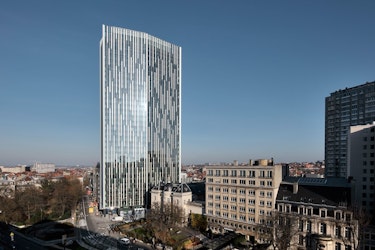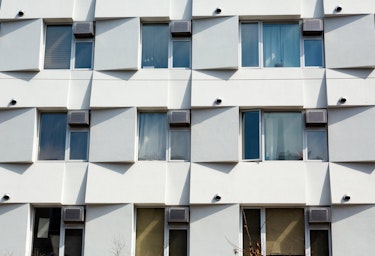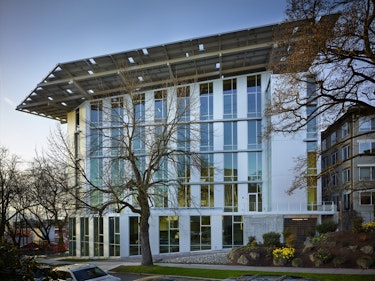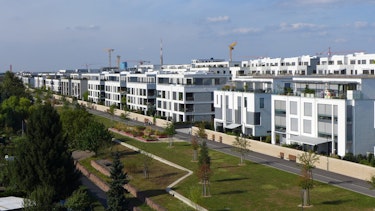Sustainability has become a paramount consideration in contemporary architecture and urban planning due to the pressing issues of climate change and environmental degradation. Passive buildings represent a noteworthy solution in the quest for sustainable architecture, offering a method for reducing energy consumption and mitigating the carbon footprint of structures. This essay delves into the concept of passive buildings, their key principles, and their contributions to decarbonizing architecture. Through an exploration of passive building techniques and their environmental benefits, we aim to elucidate their potential to revolutionize the future of sustainable.

Credit: The Astro Tower
The Concept of Passive Buildings
Passive buildings, also known as Passive House or Passivhaus, are an innovative architectural approach that emphasizes energy efficiency and comfort without relying on traditional heating or cooling systems. The fundamental concept of a passive building is to create a highly insulated, airtight structure that maintains a consistent indoor climate using minimal energy inputs. This is achieved through a combination of architectural design, high-quality building materials, and careful consideration of the building's orientation.
Key Principles of Passive Buildings
1. Superb Insulation: Passive buildings employ exceptional insulation, reducing heat loss and gain through the building envelope. This insulation prevents temperature fluctuations and minimizes the need for active heating or cooling.
2. Airtight Construction: Passive buildings are constructed with airtightness in mind, eliminating drafts and preventing energy loss through gaps and leaks in the building envelope.
3. High-Quality Windows and Doors: Passive buildings feature energy-efficient windows and doors with multiple layers of glazing to minimize heat transfer while allowing natural light and ventilation.
4. Controlled Ventilation: These structures incorporate a mechanical ventilation system with heat recovery, which ensures a constant supply of fresh air and maintains indoor air quality while recovering heat from the outgoing air.
5. Solar Gain Optimization: Passive buildings are designed to maximize solar gain during the winter months and minimize it during the summer through careful placement of windows and overhangs.
Certification and Standards
To be officially recognized as a passive building, a structure must meet stringent certification criteria. Various organizations, such as the Passive House Institute, set the standards for passive building certification. These standards encompass specific requirements for energy consumption, airtightness, ventilation, and overall building performance. Compliance with these standards ensures that passive buildings deliver on their promise of energy efficiency and environmental sustainability.

Credit: The New York Times
Environmental Benefits of Passive Buildings
The adoption of passive building principles in architecture offers a wide range of environmental benefits. These benefits have the potential to significantly contribute to the decarbonization of the built environment and reduce the overall carbon footprint of urban areas.
Energy Efficiency
1. Reduced Energy Consumption: Passive buildings can reduce energy consumption for heating and cooling by up to 90% compared to conventional buildings. This drastic reduction is primarily achieved through the building's insulation and airtightness.
2. Lower Carbon Emissions: By minimizing the need for fossil fuel-based heating and cooling systems, passive buildings contribute to lower carbon emissions, thus aligning with global efforts to combat climate change.
Reduced Dependency on Fossil Fuels
1. Solar and Renewable Energy Integration: Passive buildings are often equipped with solar panels or other renewable energy sources to meet their minimal energy demands, further reducing reliance on fossil fuels.
2. Energy Independence: Passive buildings have the potential to operate off the grid or to contribute surplus energy back to the grid, making them a part of the solution to the energy crisis.
Indoor Air Quality and Comfort
1. Enhanced Indoor Air Quality: The controlled ventilation systems in passive buildings ensure a constant supply of fresh air, improving indoor air quality and occupant well-being.
2. Thermal Comfort: The consistent indoor climate created by passive building design promotes thermal comfort, reducing the need for additional heating or cooling.
Longevity and Durability
1. High-Quality Construction: Passive buildings are typically built to a high standard, using durable materials and construction techniques, which extend the lifespan of the structure and reduce the need for maintenance or replacement.

Credit: Healthy Urbanism
Challenges and Considerations
While passive buildings hold significant promise for sustainable architecture, they are not without challenges and considerations that need to be addressed.
Upfront Costs
1. Initial Investment: The construction of passive buildings can be more expensive than traditional structures due to the need for high-quality materials and precise construction methods.
2. Long-Term Savings: While the initial cost is higher, the long-term operational savings in terms of energy bills can offset the initial investment.
Adaptation to Local Climates
1. Climate Variability: Passive building principles must be adapted to suit local climates and microclimates to ensure optimal performance in different regions.
2. Architectural Flexibility: Achieving passive building standards may require alterations to architectural design, which might not always align with aesthetic preferences or cultural norms.
Skilled Workforce and Training
1. The construction of passive buildings demands a workforce skilled in energy-efficient construction techniques and the installation of advanced building systems. Providing the necessary training and education to builders and architects is crucial to the widespread adoption of passive building methods.

Credit: Inhabit
Success Stories
To underscore the practicality and efficacy of passive buildings, it is essential to examine real-world examples and success stories. Several projects around the world have showcased the potential of passive building techniques in diverse contexts, proving their adaptability and feasibility.
The Bullitt Center, Seattle, USA
1. The Bullitt Center in Seattle, often referred to as the greenest commercial building in the world, achieved Passive House certification while generating more energy than it consumes through its solar panels. This landmark project demonstrates that passive buildings can be not only sustainable but also commercially viable.
2. The Bullitt Center's commitment to environmental sustainability extends to its choice of materials, water conservation practices, and responsible waste management. These additional sustainable practices enhance the building's overall environmental impact.
The Beddington Zero Energy Development (BedZED), London, UK
1. BedZED is a pioneering mixed-use development designed using passive building principles. It features a range of innovative sustainability features, including renewable energy sources, rainwater harvesting, and sustainable materials. The development has reduced energy consumption and carbon emissions while promoting a sense of community and sustainable living.
2. BedZED serves as a model for urban development, illustrating how passive building techniques can be integrated into large-scale projects to create sustainable and livable communities.
Bahnstadt, Heidelberg, Germany
1. Bahnstadt, a district in Heidelberg, Germany, boasts a large-scale passive building development that emphasizes sustainable urban planning and sustainable mobility options. The district is designed to be carbon-neutral and car-free, promoting alternative transportation methods and reducing the environmental impact of its residents.
2. Bahnstadt illustrates the potential of passive buildings to not only reduce individual carbon footprints but also transform entire urban areas into sustainable, low-impact communities.

Credit: C40 Stories
The Future of Passive Buildings
The adoption and expansion of passive buildings are crucial for a sustainable future. As we look ahead, several trends and developments are poised to shape the future of passive buildings and sustainable architecture.
Policy and Regulation
1. Governments and local authorities are increasingly recognizing the importance of sustainable construction. Policies and regulations are being put in place to incentivize or mandate passive building standards, making it more financially attractive and legally necessary for builders and developers to adopt these methods.
2. Financial incentives, such as tax credits and subsidies for passive building projects, can make the initial investment more appealing to developers, accelerating the transition to sustainable architecture.
Technological Advancements
1. Ongoing advancements in building materials and technology are enhancing the feasibility and cost-effectiveness of passive buildings. Improved insulation materials, energy-efficient appliances, and smart building systems contribute to the overall performance and affordability of passive construction.
2. Innovative solutions for energy generation and storage, such as advanced solar panels and energy-efficient batteries, are becoming more accessible, further reducing a passive building's reliance on the grid.
Collaboration and Knowledge Sharing
1. Architects, builders, and developers are increasingly sharing knowledge and best practices related to passive building techniques. This collaborative approach accelerates the dissemination of expertise and experience, enabling more professionals to embrace passive building methods.
2. Educational institutions and organizations are offering training and certification programs for architects and builders interested in specializing in passive building design and construction.
Global Adoption
1. Passive building principles are being embraced worldwide, transcending geographical and cultural boundaries. As global concern for the environment grows, the principles of passive buildings are being adapted to suit diverse regions and climates, further expanding their reach and impact.
2. International cooperation and information exchange are promoting the standardization of passive building practices and the sharing of successful case studies, fostering a global movement toward sustainable architecture.

Credit: M A Building
Passive buildings offer a promising pathway towards sustainable architecture and the decarbonization of the built environment. Through meticulous design and adherence to specific standards, these structures demonstrate the potential to significantly reduce energy consumption, carbon emissions, and reliance on fossil fuels while enhancing indoor comfort and air quality. Although challenges exist, their environmental benefits and the success stories of real-world projects underscore their feasibility and effectiveness. As the world grapples with the urgency of climate change, passive buildings stand as a beacon of hope for a more sustainable and environmentally responsible future in architecture.
In the face of climate change and environmental degradation, the significance of passive buildings cannot be overstated. By embracing these principles, architects and builders have the opportunity to create a built environment that is not only energy-efficient and environmentally responsible but also comfortable and healthy for its inhabitants. As we continue to seek innovative solutions to reduce our carbon footprint and combat climate change, passive buildings offer a tangible and proven path to a more sustainable future for architecture and urban development.
.jpg?ixlib=gatsbyFP&auto=compress%2Cformat&fit=max&q=75&w=375)